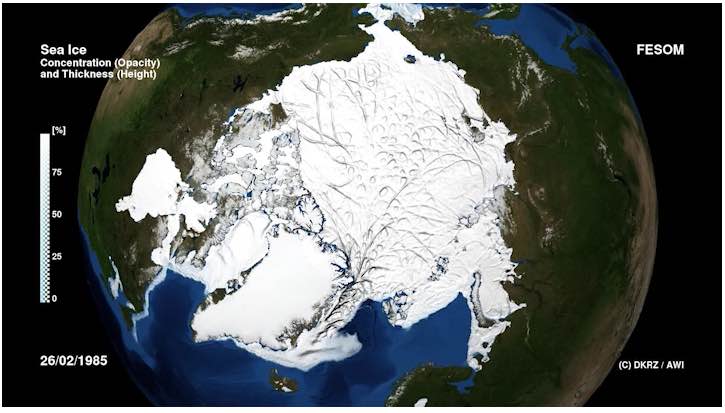Visualization of the simulated sea ice development for 1985-2014. Concentration is shown with color; thickness is shown with shading. Visualization by Michael Böttinger, DKRZ.
 Researchers at DKRZ are using supercomputers to better understand the movement of sea ice.
Researchers at DKRZ are using supercomputers to better understand the movement of sea ice.
Sea ice is an important component of the Earth System, which is often being discussed in terms of integrated quantities such as Arctic sea ice extent and volume. Sea ice deformation characteristics such as leads, on the other hand, have attracted relatively little attention thus far. Leads may play an important role, despite of the fact that they cover only a relatively small fraction of the total Arctic sea ice area. Despite of the importance of sea ice leads, relatively little is known on how well they can be represented by commonly used sea ice models. The goal of this work is to show that small scale sea ice linear features can be simulated by the traditional sea ice models with a certain skill. The prerequisite is a sufficiently high horizontal resolution along with numerical convergence of sea ice solvers which is frequently neglected. We simulate Arctic sea ice using the elastic-visco-plastic (EVP) approach in a global sea ice ocean model at a local resolution of 4.5 km and show that many characteristics of the simulated ‘cracks’ agree with the available observations already at this resolution. This allows us to discuss the variability and trend of the lead features from long model-generated time series.
The simulations were performed with the Finite Element Sea-ice Ocean Model (FESOM, see Wang et al., 2014, Danilov et al., 2015), which is the first mature global sea ice-ocean model that is formulated on unstructured meshes.
According to the simulations (and observational data) there is little evidence for the presence of significant trends in lead area fraction during wintertime. This is linked to the fact that Arctic wind stress has no significant trend so far. It remains to see whether lead area fraction in winter will increase in projected climate simulations.
Source: DKRZ



